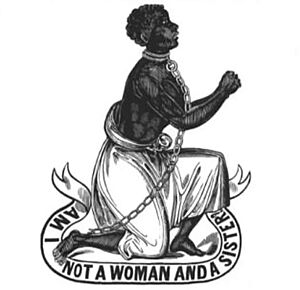Elizabeth Margaret Chandler facts for kids
Quick facts for kids
Elizabeth Margaret Chandler
|
|
|---|---|

Elizabeth Margaret Chandler, The Poetical Works (pub. 1836) - frontispiece
|
|
| Born | December 24, 1807 Centre, Delaware, U.S.
|
| Died | November 2, 1834 (aged 26) Michigan, U.S.
|
| Occupation | Writer and Poet |
Elizabeth Margaret Chandler (born December 24, 1807 – died November 2, 1834) was an American writer and poet. She was the first woman in the United States to focus her writing mainly on ending slavery. She used her powerful words to fight for freedom and equality.
Early Life and Education
Elizabeth was born on Christmas Eve, 1807, in Centre, Delaware. Her parents were Thomas and Margaret Chandler. She had two older brothers, William and Thomas. Her family belonged to the Religious Society of Friends (also known as Quakers). Quakers live a simple, organized, and disciplined life.
By the time Elizabeth was nine years old, both her parents had passed away. She and her brothers then went to live with their grandmother, Elizabeth Guest Evans, in Philadelphia, Pennsylvania. Elizabeth went to a Quaker school. There, she learned about the Quaker belief that slavery was wrong. Elizabeth started writing poems when she was very young. She left school around age twelve or thirteen, but she loved to read and write and continued to do so.
A Voice for Change
Elizabeth Chandler's first poems about nature were published when she was just sixteen. In 1825, when she was eighteen, her moving poem, "The Slave-Ship", was published. This poem caught the attention of people across the country.
After reading her poem, Benjamin Lundy invited Elizabeth to write for his newspaper, The Genius of Universal Emancipation. Lundy was a well-known abolitionist, meaning he worked to end slavery. Elizabeth wrote for and edited the "Ladies' Repository" section of his newspaper. She used her writing to encourage women to demand better treatment for Native Americans and the immediate freedom of enslaved people.
Elizabeth became one of the most influential female writers of her time. She often wrote about the sad stories of enslaved women being separated from their children and husbands. She did this to gain sympathy from her female readers. When some people said that women did not have the power to end slavery, Chandler replied that mothers have a special role:
...to give the first bent to the minds of those, who at some future day are to be their country's counselors.
It is hard to know exactly how much her writings influenced everyone. However, many of her articles were copied and shared in popular newspapers of the time. She also helped make famous one of the most well-known abolitionist images. This image showed a kneeling enslaved woman with the slogan "Am I not a Woman and a Sister". This image was inspired by a similar one used for a male slave. Two years later, William Lloyd Garrison, a leader in the abolitionist movement, used this symbol and slogan for the ladies' section of his newspaper, The Liberator. This was one of the most important anti-slavery newspapers of that time.
Moving to Michigan
In 1830, Elizabeth Margaret Chandler moved to the territory of Michigan with her aunt and brother. Her brother, Thomas Chandler, bought land near Tecumseh, Michigan in Lenawee County. This was about sixty miles southwest of Detroit. They planned to start a farm and called their new home Hazlebank.
From this, her quiet and secluded retreat, emanated some of the choicest productions of her pen.
Even from her quiet farm, Chandler continued to take part in national discussions about ending slavery through her articles and poems. She also kept editing Benjamin Lundy's abolitionist newspaper.
While living in Philadelphia, Chandler had been a member of a Female Anti-Slavery Society. After moving to Michigan, she started the Logan Female Anti-Slavery Society in 1832. She founded it with her friend and neighbor Laura Smith Haviland.
Elizabeth wrote:
Terrible in crime and magnitude as the slavery of our country is, I do not despair — apathy must — will awaken, and opposition die — the cause of justice must triumph, or our country must be ruined.
The Logan Female Anti-Slavery Society helped create an important stop on the Underground Railroad to Canada. The Underground Railroad was a secret network that helped enslaved people escape to freedom.
Her Legacy
Elizabeth Chandler passed away from a fever on November 2, 1834. She was almost 27 years old. She was buried near her family's farm at Hazlebank. After her death, Benjamin Lundy collected her articles, poems, and letters. He published them as two books. The money from selling these books went to support the fight against slavery. Elizabeth Margaret Chandler's words continued to inspire people even after she was gone.
See also
 In Spanish: Elizabeth Margaret Chandler para niños
In Spanish: Elizabeth Margaret Chandler para niños


